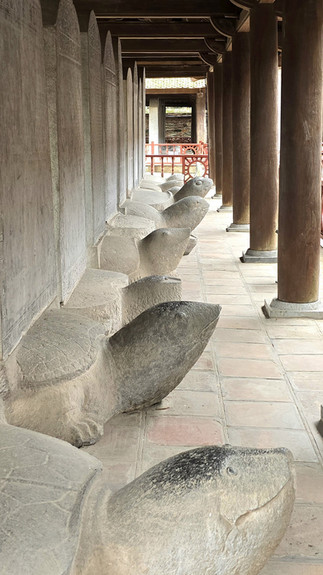The Temple of Literature
- Shannon
- Sep 25
- 4 min read
Hanoi's Guardian of Knowledge
Known locally as Văn Mieu, The Temple of Literature stands as one of Vietnam’s most treasured historical and cultural landmarks. Founded in 1070AD under Emperor Lý Thánh Tông, this sacred site was originally dedicated to Confucius, the revered master of learning and philosophy. Its purpose was spiritual and ceremonial, a place where the Emperor and his Mandarins could perform rituals to show respect and devotion for Confucius and the values of education, virtue and loyalty.

After the sudden death of the Emperor in 1072, his 7 year old son Lý Nhân Tông succeeded the throne. In 1076, the temple expanded into Quoc Tu Giám, the country’s very first university. The Imperial Academy was established to educate the most gifted sons of Mandarins, sages and the nations brightest minds, in the pursuit of scholarly perfection. Later, commoners were also permitted to study here to become Mandarins of the royal court.

The Temple of Literature’s architecture reflects traditional Vietnamese design, mirroring the Confucian journey towards wisdom and balance. Inside its walls, the complex is arranged around five successive courtyards, each featuring landscaped gardens, ancient banyan trees and symbolic elements like the Well of Heavenly Clarity. Other key structures include the Đai Trung Gate, the House of Ceremonies and the Sanctuary of Confucius, where offerings are still made today.

The iconic Turtle Stelae, sheltered under curved roof pavilions, immortalise generations of scholars who passed the royal examinations between 1442 and 1779. Each stone rests on the back of a turtle and records the names and achievements of successful candidates. Today, 82 stelae remain, recognised by UNESCO as invaluable historical records. Across the temple grounds, intricate carvings of dragons, phoenixes, unicorns and turtles embody Confucian virtues like power, integrity and wisdom, reinforcing the temple’s role as both a spiritual and intellectual sanctuary.

The royal examinations at Quoc Tu Giám were fiercely competitive and brutally difficult. Passing them was the only path to secure a prestigious position within the imperial government, a prize that demanded years (often decades) of gruelling study in Confucian philosophy, classical literature and statecraft. For many, it was an all-consuming pursuit. Failure wasn’t just a personal disappointment, it carried deep shame, often devastating a scholar’s family standing and future prospects. Success brought honour and power, failure brought silence and stigma.

According to Hànoi folklore, the pressure was so overwhelming that some students committed suicide in secluded corners within the temple grounds. A few are said to have drowned themselves in the Well of Heavenly Clarity, while others hanged from the gnarled branches of the old banyan trees. Their stories, passed down through generations, speak of restless spirits trapped in the corridors of the temple, forever burdened by the disgrace of failure and eternally trapped by their own personal shame.

Across nine centuries, the Temple of Literature bore witness to the rise and fall of dynasties, the grip of French colonisation and the turmoil of war. Remarkably, despite Hànoi being heavily bombed during the Indochina Wars of the 20th century, the temple was spared major destruction. This unlikely survival is often credited to its sacred status among locals and its location, just beyond the range of key military targets. Its preservation through such violent upheaval has only deepened its cultural and symbolic importance.

Today, the Temple of Literature stands not just as a historical monument but as a living institution. Students and scholars still visit to pray for academic success, especially before important exams. The temple now hosts calligraphy festivals, academic ceremonies and traditional performances that animate its ancient courtyards. It continues to serve as a museum, a centre of cultural heritage and a lasting symbol of national pride and intellectual continuity.

🗺️ Location
58 Quoc Tu Giám Street, Văn Mieu, Đong Đa District, Hànoi, Vietnam
🚆 How to get there
The Temple of Literature is easy to reach from any part of Hànoi. It is 2km's and roughly 30 minutes walk from Hoan Kiem Lake in the Old Quarter. Alternatively, you can grab a taxi or motorbike for around 30000VND and it will take roughly 10 minutes to reach. There are also several public buses that all stop regularly near the temple entrance.
⭐ Attraction Info
The temple welcomes visitors daily between 7:30am - 6pm and on Wednesdays, Fridays, Saturdays and Sundays between 6:30pm - 10pm for night tours. Tickets for standard day entry cost 35000VND for students or 70000VND for adults and are available to purchase at the main entrance gate to the complex but bring cash as cards are not accepted. The night tour costs 199,000 VND for adults or 99,000 VND for children. This historic attraction is extremely popular, so an early morning or late afternoon visit will help you avoid the crowds. Audio guides are available for a small additional fee and the complex houses a cafe and souvenir shop. Ensure you dress respectfully, as this is considered a sacred site.
🔗Official Website
Thanks for reading about The Temple of Literature. Check out more awesome destinations here!
















































